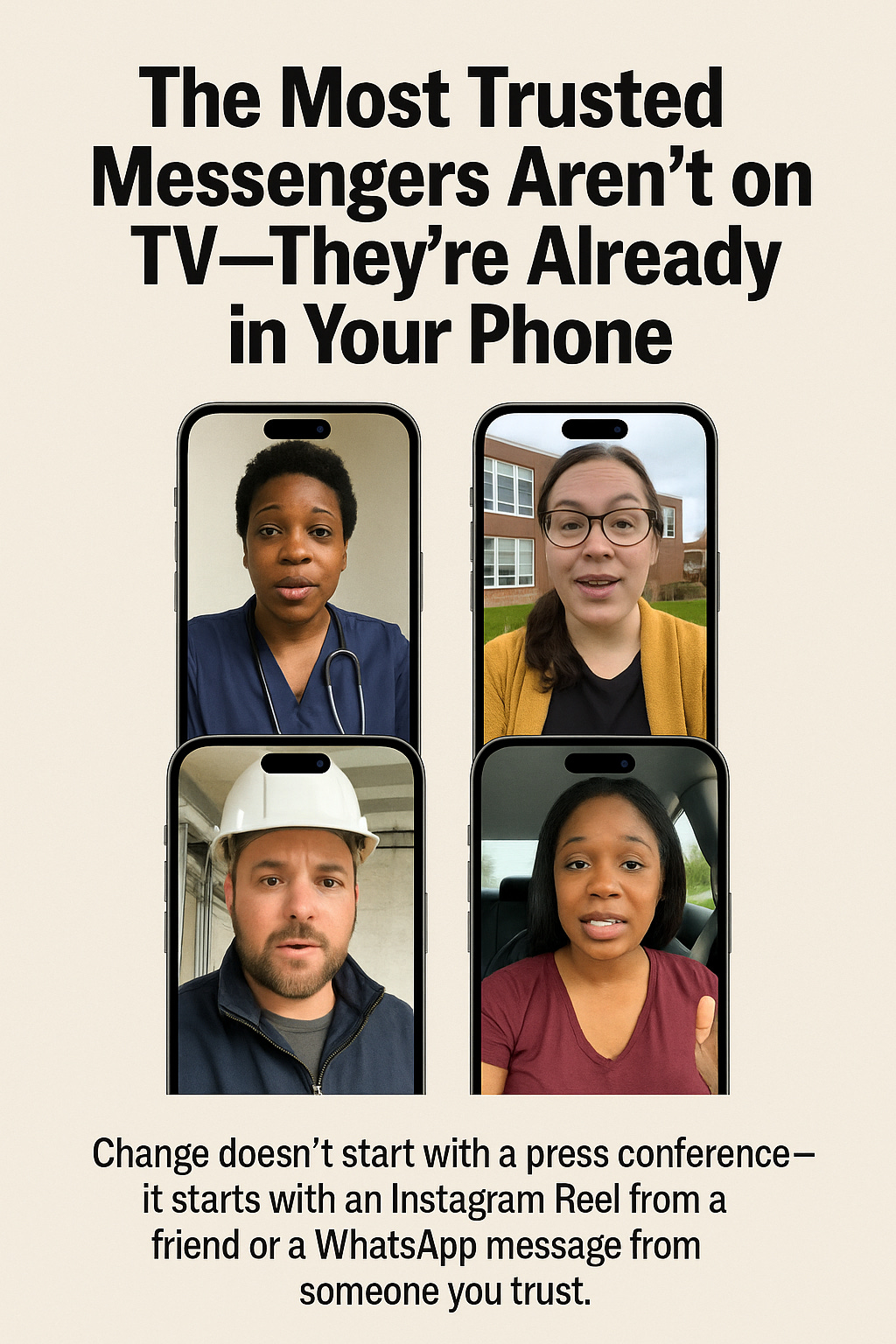The Most Trusted Messengers Aren’t on TV - They’re in Your Phone and Just Down the Street
They’re not polished or paid to persuade. They’re neighbors, coworkers, and cousins—sharing WhatsApp messages, posting Instagram Reels, and building trust one conversation at a time.
What We Need to Do Next
If there’s one thing we’ve learned over the last few years, it’s this: top-down campaigns and national messages alone won’t cut it. The right has built a 24/7 media ecosystem rooted in fear, outrage, and disinformation - and it’s thriving in the absence of trusted, local, community-driven alternatives. If we’re going to meet this moment and win lasting change, we need to build something different. Something deeper. Something real.
So what do we do next?
1. Invest in Local Social Media That Feels Like Home
We need to stop thinking of social media as a billboard - and start thinking of it as a town square. In too many communities, especially in small towns and rural areas, the only consistent voices online are right-wing content farms, gossip pages, and culture war clickbait. Meanwhile, our side parachutes in with expensive ads during election season and disappears the day after.
That’s not how trust is built.
We need permanent local pages and groups that are rooted in community. These aren’t campaign pages - they’re neighborhood bulletin boards, small business spotlights, school sports boosters, hiking groups, veteran’s networks, caregiving forums, and parenting chats. They don’t start with ideology. They start with connection. And when trust is built, they become powerful vehicles for truth, values, and mobilization.
If we want to counter disinformation, we need to create digital infrastructure people actually want to spend time in. That means funding and maintaining Facebook pages, TikTok accounts, Instagram stories, WhatsApp groups, and even local email newsletters that reflect the voice, humor, and rhythm of the community - not the tone of a national press release.
Our content should feel local-not focus-grouped. It should show up in the scroll naturally, not just as an ad buy. Local social media is part of the solution.
2. Find Local Messengers, Not Spokespeople
People don’t trust institutions anymore. They trust people they know. Or people who remind them of someone they know. That’s why our messages land best when they come from real people with real stories - not polished surrogates or outsiders with talking points.
Local messengers are barbers, church ushers, bus drivers, high school coaches, union stewards, home health aides, and small business owners. They’re your aunt with a strong opinion, your coworker who always shares the good memes, your friend who volunteers on weekends.
They don’t need to go viral-they just need to be visible. And to be themselves.
We should be training and supporting these community connectors-not just to post content, but to shape it. To respond to disinformation. To tell their story in a way that resonates. To create short TikToks, post reels, text their circles on WhatsApp, share memes, and build followings. The right has its influencers. We have our neighbors.
3. Communicate Differently: Culture Crushes Credentials
Too often, we mistake authority for persuasion. We think if we just find the right expert, the right fact-check, the right credential, people will listen. But people aren’t moved by facts alone. They’re moved by culture—by what feels familiar, human, and real.
We need to flip the script.
Communication can’t just be one-way broadcasting. It has to be two-way: rooted in listening, not just message delivery. Our goal isn’t just to inform - it’s to connect. That means asking more questions, sharing stories instead of scripts, and showing up in comment sections, DMs, group chats, and even WhatsApp chains where people already are.
People aren’t looking for perfection - they’re looking for someone who gets them.
We need to stop acting like we’re talking at a focus group and start acting like we’re talking with a neighbor. That means acknowledging fears, meeting people where they are, and being okay with messy, real conversations. Because when it comes to trust and influence, culture will always crush credentials.
4. Make Organizing Relational Again
Every piece of research tells us the same thing: conversations with people you know are the most powerful form of persuasion and mobilization. That’s the heart of relational organizing. But too often we reduce it to a contact list and a script.
Relational organizing isn’t about checking boxes. It’s about building culture - where it becomes normal to talk about what’s going on in your town, what’s at stake in an election, and how to support each other. It means making sure our digital spaces mirror our organizing principles: rooted in relationship, not just reach.
We should be asking:
Who already talks to a lot of people in their everyday life?
Who’s already trusted on Facebook, TikTok, or WhatsApp?
Who could start a conversation that ripples outward?
And then we should give them what they need: support, content, training, trust.
We Don’t Need to Outshout the Right. We Need to Outorganize Them.
That starts with investing in local media year-round, not just during campaign season. It means finding and lifting up real voices—not perfect voices. It means getting serious about digital and relational organizing as core infrastructure, not just add-ons.
What we build now—online and offline—will determine what’s possible in 2026, 2028, and beyond.
Let’s build something real. Let’s build something that lasts.


I like it! Tell me more! Has something like this been done before? Can you talk about some real-world examples?
Better yet, organized discussion groups in your neighborhood. An old-fashioned salon. Face to face. Pick a topic, cite some sources, and invite your neighbors over to talk. I did it and was amazed. I'll post about it soon.